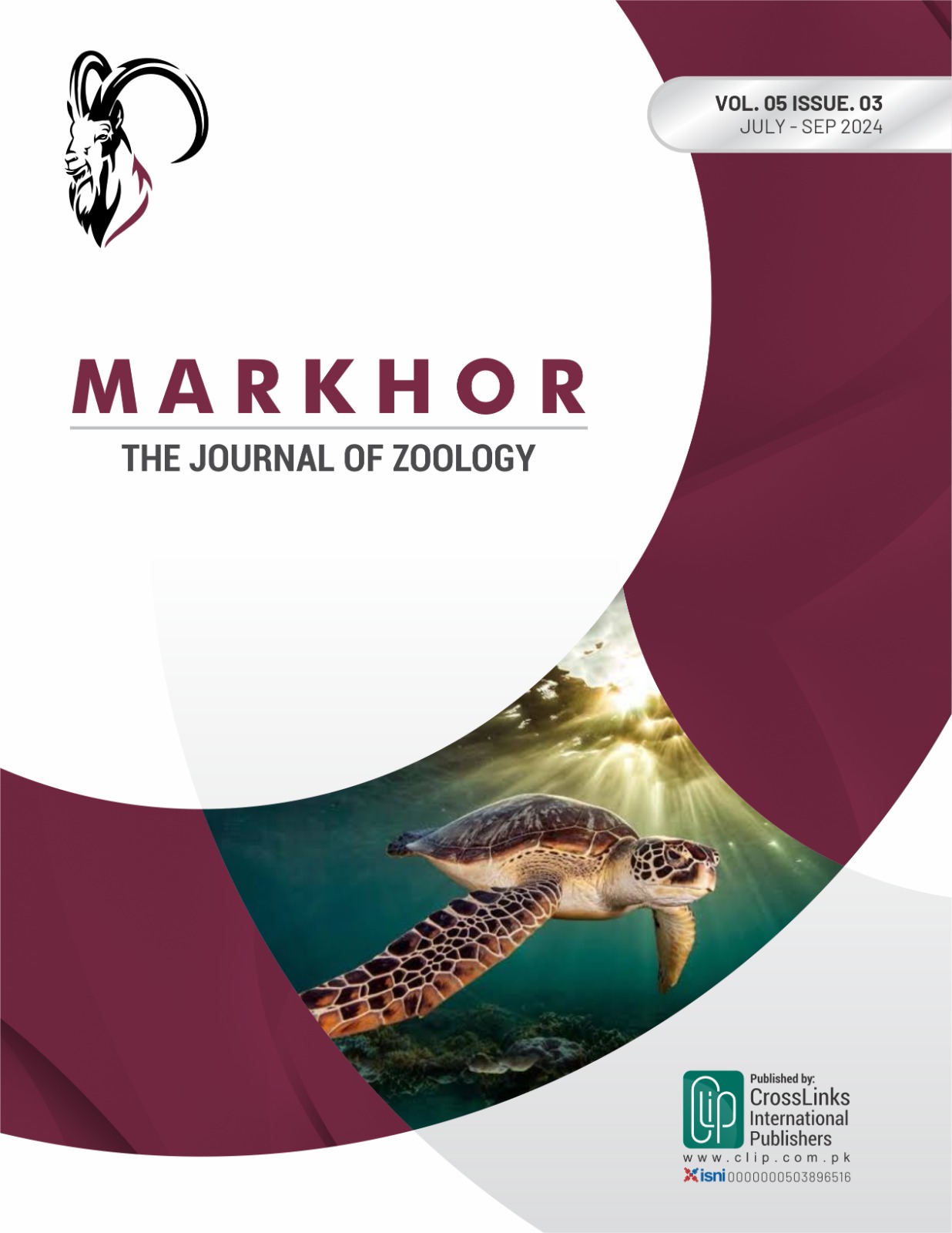Prevalence and Chemotherapy of Canine Monocytic Ehrlichiosis in Lahore, Pakistan
Prevalence and Chemotherapy of Canine Monocytic Ehrlichiosis
DOI:
https://doi.org/10.54393/mjz.v5i03.151Keywords:
Ehrlichia canis, Microscopy, Immunochromatography, Ticks, RifampicinAbstract
Preventing animals from vector-borne diseases is of prodigious concern in the current era. Objective: To estimate the prevalence of Canine Monocytic Ehrlichiosis (CME) (Ehrlichia canis) in Lahore, Pakistan. Methods: For initial diagnosis, microscopy was performed. Later on, anti-E. canis antibodies were detected through immunochromatography (ICA) based Ehrlichia canis Ab tests (Quicking biotech ®). A total of 100 dogs showing clinical signs of CME were tested, and an overall seroprevalence rate of 29% was noticed. The success rate of microscopy was observed to be 3% in the present study. Results: Occurrence of CME was not statistically associated with age, sex, and breed (p>0.05), while body condition (p<0.001) and tick infestation (p=0.004) were significantly associated with CME. Moreover, blood parameters, including Hb, RBC count, WBC count, and Total platelet count, were decreased (p<0.001) in the infected animals. Rifampicin was found to be more effective in diminishing clinical signs and normalization of blood parameters as compared to Doxycycline. Conclusions: Dogs in Lahore are at great risk of acquiring CME due to increased tick population and lack of awareness among owners. For rapid diagnosis and timely treatment against the infection, veterinarians can use ICA-based rapid test kits as an effective tool. In addition, Rifampicin is found to be more effective than Doxycycline, and may be preferred for the treatment of Canine Monocytic Ehrlichiosis.
References
Ferrolho J, Antunes S, Vilhena H, Anastácio S, Ramalho de Sousa S, Frouco G et al. The Complexities of Canine Monocytic Ehrlichiosis: Insights into Ehrlichia canis and Its Vector Rhipicephalus sanguineus. Microbiology Research. 2025 Apr; 16(4): 85. doi: 10.3390/microbiolres16040085.
Zhang G, Naeem MI, Akhtar T, Younus M, Nisa QU, Ameer T et al. Ehrlichiosis: Tick-Borne Malady. One Health Triad, Unique Scientific Publishers, Faisalabad, Pakistan. 2023; 3: 69-77. doi: 10.47278/book.oht/2023.79.
Groth M, Skrzydlewska E, Dobrzyńska M, Pancewicz S, Moniuszko-Malinowska A. Redox Imbalance and Its Metabolic Consequences In Tick-Borne Diseases. Frontiers in Cellular and Infection Microbiology. 2022 Jul; 12: 870398. doi: 10.3389/fcimb.2022.870398.
Masika SJ. Prevalence and Genetic Characterization of Anaplasma Phagocytophilum in Olive Baboons and Vervet Monkeys in Laikipia County, Kenya (Doctoral dissertation, Uon). 2021. doi: 10.21203/rs.3.rs-355087/v1.
Marshet B and Dessie D. A Review on Canine Ehrlichiosis and Its Zoonotic Implications. International Journal of Veterinary Sciences and Animal Husbandry. 2020; 5(3): 36-42.
Malik MI, Qamar M, Ain Q, Hussain MF, Dahmani M, Ayaz M et al. Molecular Detection of Ehrlichia Canis in Dogs from Three Districts in Punjab (Pakistan). Veterinary Medicine and Science. 2018 May; 4(2): 126-32. doi: 10.1002/vms3.94.
Aziz MU, Hussain S, Song B, Ghauri HN, Zeb J, Sparagano OA. Ehrlichiosis in Dogs: A Comprehensive Review About the Pathogen and Its Vectors with Emphasis on South and East Asian Countries. Veterinary Sciences. 2022 Dec; 10(1): 21. doi: 10.3390/vetsci10010021.
Mylonakis ME and Theodorou KN. Canine Monocytic Ehrlichiosis: An Update on Diagnosis and Treatment. Acta Veterinaria (Beograd). 2017; 67(3): 299-317. doi: 10.1515/acve-2017-0025.
Checa R, Peteiro L, Pérez-Hernando B, de la Morena M, Cano L, López-Suárez P et al. High Serological and Molecular Prevalence of Ehrlichia Canis and Other Vector-Borne Pathogens in Dogs from Boa Vista Island, Cape Verde. Parasites and Vectors. 2024 Sep; 17(1): 374. doi: 10.1186/s13071-024-06437-9.
Moonarmart W, Sungpradit S, Rawangchue T, Suphaphiphat K, Suksusieng S, Jirapattharasate C. Clinical History and Hematological Findings among Canines with Monocytic Ehrlichiosis. Southeast Asian Journal of Tropical Medicine and Public Health. 2014; 45(1): 157.
Jaheen AH, Kubesy AA, Rakha GM, Salem SI, El-Sherif MA. Diagnostic Value of Procalcitonin, C-Reactive Protein, and Leukocyte Count in Canine Ehrlichiosis and Canine Demodicosis. Comparative Clinical Pathology. 2022 Jun; 31(3): 529-36. doi: 10.1007/s00580-022-03350-4.
Ramakant RK, Verma HC, Diwakar RP. Canine Ehrlichiosis: A Review. Journal of Entomology and Zoology Studies. 2020; 8(2): 1849-52.
De Villiers L, Schoeman JP, Penzhorn BL, Molini U, de Villiers M, Makgabo SM et al. Prevalence, Diagnostic Evaluation, and Disease Associations of Vector-Borne Pathogens in Domestic Dogs Across Namibia: A Multi-Modal Approach. Parasites and Vectors. 2025 Jul; 18(1): 275. doi: 10.1186/s13071-025-06906-9.
Rikihisa Y. The tribe Ehrlichieae and Ehrlichial Diseases. Clinical Microbiology Reviews. 1991 Jul; 4(3): 286-308. doi: 10.1128/CMR.4.3.286.
Woody BJ and Hoskins JD. Ehrlichial Diseases of Dogs. Veterinary Clinics of North America: Small Animal Practice. 1991 Jan; 21(1): 75-98. doi: 10.1016/S0195-5616(91)50009-7.
Razi Jalali MH, Mosallanejad B, Avizeh R, Alborzi AR. Seroprevalence of Ehrlichia canis in dogs referred to Veterinary Hospital of Shahid Chamran University of Ahvaz, Iran. Archives of Razi Institute. 2010 Sep; 65(1): 21-6.
Sainz Á, Roura X, Miró G, Estrada-Peña A, Kohn B, Harrus S et al. Guideline for Veterinary Practitioners on Canine Ehrlichiosis and Anaplasmosis in Europe. Parasites and Vectors. 2015 Feb; 8(1): 75. doi: 10.1186/s13071-015-0649-0.
Iatta R, Sazmand A, Nguyen VL, Nemati F, Ayaz MM, Bahiraei Z et al. Vector-Borne Pathogens in Dogs of Different Regions of Iran and Pakistan. Parasitology Research. 2021 Dec; 120(12): 4219-28. doi: 10.1007/s00436-020-06992-x.
Bai L, Goel P, Jhambh R, Kumar P, Joshi VG. Molecular Prevalence and Haemato-Biochemical Profile of Canine Monocytic Ehrlichiosis in Dogs in and Around Hisar, Haryana, India. Journal of Parasitic Diseases. 2017 Sep; 41(3): 647-54. doi: 10.1007/s12639-016-0860-8.
Baharie Yazdi M, Pourmahdi Borujeni M, Mosallanejad B, Gharibi D. Seropervalence and Risk Factors of Canine Ehrlichiosis in Urban and Rural Dogs in Ahvaz. Iranian Veterinary Journal. 2018 Sep; 14(3): 5-13.
Kukreti K, Pandey L, Das M, Rastogi A, Dubey R, Sharma P. Prevalence of Canine Monocytic Ehrlichiosis in Canine Population Across India. Archives of Razi Institute. 2018 Jun; 73(2): 87-93.
Stich RW, Blagburn BL, Bowman DD, Carpenter C, Cortinas MR, Ewing SA et al. Quantitative Factors Proposed to Influence the Prevalence of Canine Tick-Borne Disease Agents in the United States. Parasites and Vectors. 2014 Sep; 7(1): 417. doi: 10.1186/1756-3305-7-417.
Selim A, Abdelhady A, Alahadeb J. Prevalence and First Molecular Characterization of Ehrlichia Canis in Egyptian Dogs. Pakistan Veterinary Journal. 2020 Jul; 41(1): 117-21. doi: 10.29261/pakvetj/2020.061.
Dhliwayo S, Chihambakwe B, Taonezvi K, Chikerema SM, Tivapasi MT, Pfukenyi DM. Seroprevalence of Canine Ehrlichiosis and Microscopic Screening for Canine Babesiosis in Dogs in Harare, Zimbabwe, 2016‐2017. Veterinary Medicine International. 2019; 2019(1): 4130210. doi: 10.1155/2019/4130210.
Botros BA, Elmolla MS, Salib AW, Calamaio CA, Dasch GA, Arthur RR. Canine Ehrlichiosis in Egypt: Sero-Epidemiological Survey. 1995.
Milanjeet M, Harkirat Singh HS, Singh NK, Singh ND, Chanchal Singh CS, Rath SS. Molecular Prevalence and Risk Factors for the Occurrence of Canine Monocytic Ehrlichiosis. Veterinarni Medicina. 2014; 59(3): 129–136. doi: 10.17221/7380-VETMED.
Parashar R, Sudan V, Jaiswal AK, Srivastava A, Shanker D. Evaluation of Clinical, Biochemical and Haematological Markers in Natural Infection of Canine Monocytic Ehrlichiosis. Journal of Parasitic Diseases. 2016 Dec; 40(4): 1351-4. doi: 10.1007/s12639-015-0688-7.
Schaefer JJ, Kahn J, Needham GR, Rikihisa Y, Ewing SA, Stich RW. Antibiotic Clearance of Ehrlichia Canis from Dogs Infected by Intravenous Inoculation of Carrier Blood. Annals of the New York Academy of Sciences. 2008 Dec; 1149(1): 263-9. doi: 10.1196/annals.1428.087.
Akhtardanesh B, Ghanbarpour R, Sharifi H. Comparative Study of Doxycycline and Rifampin Therapeutic Effects in Subclinical Phase of Canine Monocytic Ehrlichiosis. Comparative Clinical Pathology. 2011 Oct; 20(5): 461-5. doi: 10.1007/s00580-010-1019-0.
Downloads
Published
How to Cite
Issue
Section
License
Copyright (c) 2024 MARKHOR (The Journal of Zoology)

This work is licensed under a Creative Commons Attribution 4.0 International License.
This is an open-access journal and all the published articles / items are distributed under the terms of the Creative Commons Attribution License, which permits unrestricted use, distribution, and reproduction in any medium, provided the original author and source are credited. For comments editor@markhorjournal.com











